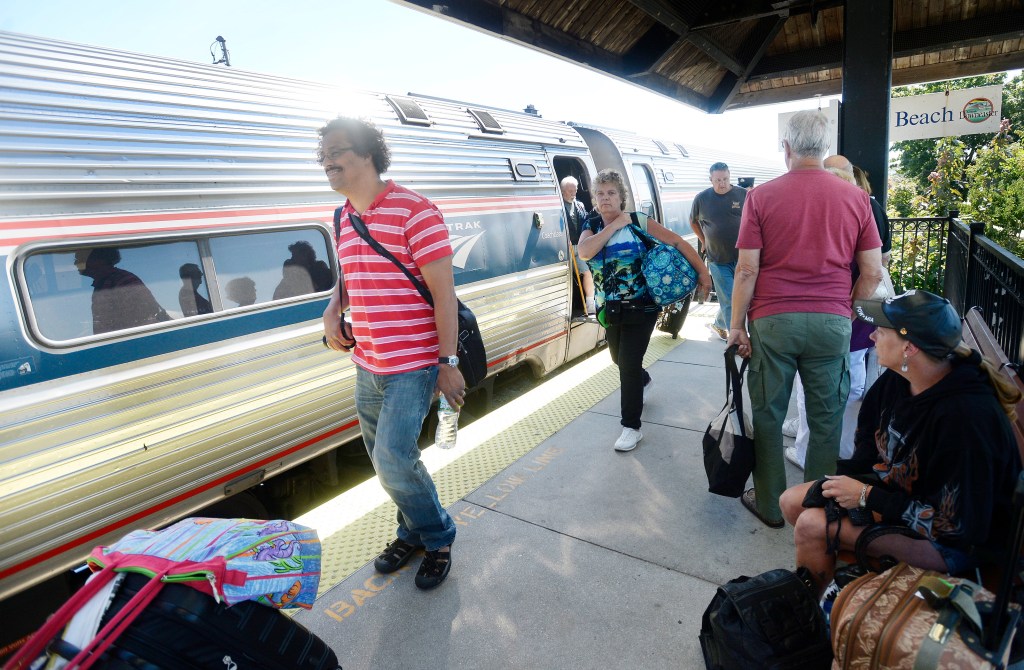Ridership on Amtrak’s Downeaster increased 4.6 percent in the fiscal year that ended on June 30, even though the service posted its worst-ever on-time performance, according to a preliminary report.
Passengers made a record 537,000 one-way trips on the Downeaster, which operates 10 trains daily between Portland and Boston and four daily trains between Brunswick and Boston.
But the service’s on-time performance was dismal. Only 58 percent of the trains arrived at their destination on time, a significant decline from on-time performance of 82 percent in fiscal 2013, according to the report completed by the Northern New England Passenger Rail Authority.
Any number below 80 percent is considered substandard under a law Congress passed in 2008. A train is considered “on time” if it arrives at the final destination within 10 minutes of its scheduled arrival time.
Only 8 percent of trains arrived on time in May, and only 19 percent of trains arrived on time in June.
The Downeaster’s problems worsened in July, when 51 trains were canceled due to track repair projects.
The delays and cancellations were necessary to give crews time to make repairs to tracks and rail beds, said Patricia Quinn, executive director of the rail authority, the quasi-state agency that operates the service.
The MBTA, which owns the tracks in Massachusetts, repaired two bridges, she said. In addition, Pan Am Railways, which owns the line in Maine and New Hampshire, replaced 2,000 rail ties and strengthened sections of the rail bed.
Last winter’s harsh weather damaged some sections of the line, requiring trains to operate more slowly, Quinn said. Crews also replaced ties that should have been replaced a year ago. The work was delayed because the railroad didn’t receive the ties on time, she said.
The unusually cold and stormy weather last winter caused delays throughout the Amtrak system in the Northeast and Midwest. More delays occurred in the spring when the weather warmed up and work crews were repairing damaged tracks, Amtrak spokesman Craig Schulz said.
Trains also saw more delays because the number of freight trains using rail lines increased, particularly trains hauling crude oil, Schulz said.
“We have had our share of challenges system-wide,” he said.
Nationally, Amtrak has experienced ridership growth in 10 of the past 11 years. In fiscal year 2013, Amtrak served a record 31.6 million passengers. Schulz said statistics for the past year won’t be available until after Amtrak’s fiscal year concludes on Sept. 30.
Despite its poor on-time record, the Downeaster continues to be a “strong performer” within the Amtrak system, he said.
The service’s passenger growth is “pretty impressive, especially when you consider some of the challenges the Downeaster service has encountered this year,” he said. “It speaks highly to the value the community places on the service.”
Not only are more people riding the train than in the past, they also are going farther and paying more money to ride in business class, which means increased revenues.
In fiscal 2014, ticket revenues rose from $8.1 million to $8.6 million, an increase of 6.2 percent. Spending in the dining car also increased, from $620,000 to $705,000.
The rail authority spent $18.3 million to operate the train, $700,000 below its $19 million budget.
As a result of the increased revenues and reduced spending, the authority will need less money from the state and federal government to meet its expenses, Quinn said.
The authority had anticipated it would need a subsidy of $9.8 million, but it will now require a subsidy of $8.4 million.
The federal government picks up 80 percent of the subsidy. Maine’s contribution will be $1.7 million. The money, from the Maine Department of Transportation, comes from a tax on rental cars.
According to the report, 51 percent of riders traveled between Maine and Massachusetts, and 34 percent traveled between New Hampshire and Massachusetts. The Downeaster’s newest destination, Brunswick, was the second busiest station with an average of 140 passengers per day, bested only by Portland.
Robert McEvoy is a retired highway engineer and critic of the rail authority, who was appointed to its board of directors by Gov. Paul LePage in April. McEvoy didn’t want to comment on the performance report until after he receives information he has requested from Quinn.
The report will be finalized in October after Amtrak completes its audit.
Send questions/comments to the editors.



Success. Please wait for the page to reload. If the page does not reload within 5 seconds, please refresh the page.
Enter your email and password to access comments.
Hi, to comment on stories you must . This profile is in addition to your subscription and website login.
Already have a commenting profile? .
Invalid username/password.
Please check your email to confirm and complete your registration.
Only subscribers are eligible to post comments. Please subscribe or login first for digital access. Here’s why.
Use the form below to reset your password. When you've submitted your account email, we will send an email with a reset code.